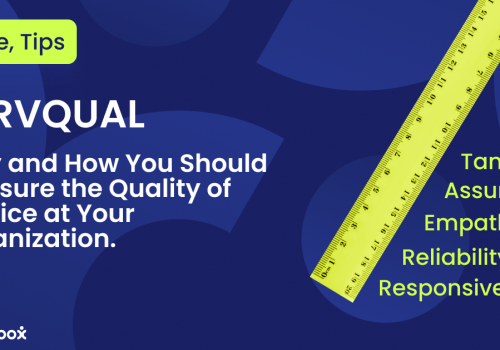Revenue Goals for Your B2B SaaS Company. When it comes to starting, nurturing, and growing your B2B SaaS business, your goals are what will guide you through every step of the way. Goals lead to success:
Goal clarity has a direct influence on overall motivation in the workplace.
When your goals are clear and easy to understand, everyone can participate in achieving them.
The need for achievement is positively related to entrepreneurial persistence.
A study by the University of Texas found that the most persistent entrepreneurs (those that don’t give up) are motivated by a deep need for achievement and use goals to keep them on track.
People who have a greater understanding of the goal’s purpose have an increased chance of achieving the goal.
When people understand a goal and its purpose, they’re much more likely to succeed because they can connect their actions to achieving the goal. When a goal isn’t clear, people struggle to see how their actions impact progress.
Despite the many benefits of setting goals and revenue goals, in particular, just 5% of small businesses achieve their yearly goals. Why? Because they’re not setting goals in the right way. Have you already set your revenue goals? If so, could you be approaching them in a better way? Today we’re going to be looking at the ultimate guide to setting your B2B SaaS revenue goals in 2021. Let’s take a look.
Don’t Borrow Other People’s Goals
When a lot of small businesses are asked what their revenue goals are, they’ll say something like “$1 million a year” or “$5 million a year.” That’s great, but where did they get that figure from? When you see people using big round numbers, it’s usually because they saw that goal somewhere else and decided to adopt it for themselves. This is a mistake. If you copy other businesses’ goals, you won’t have the resilience and determination to power through when you face challenges. You’ll feel disconnected from the goal.
Reaching Your Sales Goals
Setting high sales goals is easy. People set lofty sales goals because they’re fantasizing about the outcome. Lots of sales mean lots of income, and that means you get that car you’ve always wanted. However, achieving high sales goals is much harder, and not every B2B SaaS business does achieve them. With this in mind, here are some tips for reaching your sales goals:
- Start with the easy part: What do you want to achieve? $10,000 a month? $1 million a quarter?
- Reverse engineer the actions you need to take to achieve that goal. This is the hard part. Many businesses don’t do this part thoroughly enough, or worse, don’t do it at all. Determine the number of leads you need to have, sales you need to make, and so on to reach this goal.
- Execute the plan. By reverse-engineering the actions, you create a plan. Now you know the steps you need to take to make this plan a reality, and all that is left is putting your foot to the peddle.

The Formula For Setting B2B SaaS Revenue Goals
It All Starts and Ends With Revenue
B2B SaaS companies are well known in the business world as companies that grow quickly and achieve massive revenue goals. If you want to join these ranks, you have to start with a revenue mindset. Revenue is your ultimate goal, and everything should lead back to revenue. It should be your number one benchmark.
The elements that help you achieve your revenue goals will be activities like:
- Inbound marketing: Having a data-driven marketing team that generates opportunities for the sales team. This marketing can be in the form of blog posts, paid ads (landing pages), and email campaigns.
- Outbound sales: Engaging with decision-makers in target companies.
- Upsells: Encouraging existing customers to buy additional products or services.
To track and monitor the success of these activities, you need to be using metrics. For example, what budget do you have for these activities? What is your conversion rate? And how much does each conversion cost your business?
Get Comfortable With Doing the Math
If you don’t want to be surprised by not hitting your goals, you need to start doing the math. Work out how many conversions you get from X amount of outbound communications. Let’s say you get 50 meetings from 180 outbound communications. Of these 50, you send 20 product demos. From 20 product demos, four businesses sign up for your service.
Now you know the math behind the outbound communications, you can work out how many sales reps you need. You can also start to look for ways to make those sales reps more efficient through automation and training so that they can increase that 180 outbound communications to 200 or even more.
How to Set Goals That Will Help You Grow Quickly
Define What “Realistic” Means for Your Business
So, you’ve decided on your revenue goal and what actions need to happen to achieve it. Next, you need to see if things are working as expected. The Harvard Business Review once wrote, “When 10%–20% of salespeople miss goals, the problem might be the salespeople. But when most salespeople miss, the problem is their goals”. Pay attention to this! If you set goals and you’re not hitting your milestones, there’s a problem.
So many business owners go straight to blaming the employees without looking a little deeper at the issue. Goals have to be realistic to be achievable. And this is another reason why you shouldn’t be adopting someone else’s goals – what’s realistic for one business might not be realistic for yours. Why? Because they might be starting from a better position. It’s easier to say, “I want to finish first place in this 100-meter race,” if you’re starting from the 40M mark. Maybe your competitors have more investment, a bigger team, more sales reps, or have more industry knowledge and expertise.
If you’ve already started your B2B SaaS business, you should look at the data you already have. This can include things like:
- How many customers you got in one year?
- How much money, on average, did they bring in?
- How quickly is your customer base growing?
- Are there certain types of businesses (niches) that buy your service more often or spend more money on average when they make a purchase?
Once you’ve crunched the numbers (done the math), you’ll have a better idea of what is realistic for your business. If your goal is to grow your customer base by 150% in the next two months, ask yourself what needs to change. If you did nothing different, what would that growth look like in two months? What trajectory are you on right now? You can’t expect a tomato plant to grow without optimal food, water, and sunlight, so don’t expect the same from your business.
The next thing you need to do is assess the market potential. How much room for growth is there in your market? Is there a limit to what you can achieve? Can you adapt your service to be attractive to different market segments? Is your company vulnerable to any evolving market pressures right now?

Empower and Incentivize Your Sales Team
The success or failure of your revenue goals lies in your sales team. A happy, motivated, and well-incentivized sales team will make your goals their goals. They’ll try their hardest to achieve these goals because their success is dependent on your success as a B2B SaaS company.
Several factors go into empowering and incentivizing your sales team:
Ensure They Have the Tools They Need to Succeed
It starts with the tech. When you have the right software and hardware, we can do your job without being distracted or frustrated along the way. So many hours are lost in businesses every year due to antiquated tech and poor processes. Pick your CRM carefully. Foster an omnichannel approach from the get-go.
Pay Attention to Outliers
Do you have any outliers on your sales team? Either people who are performing very highly or very poorly? If so, what can you learn from these sales reps? For highly performing reps, you might want to take note of their strategy and use it to make a blueprint for the other sales reps. Sometimes business is as much an art as a science. One sales rep might stumble upon a new way of communicating with companies that really resonates.
Cultivate a Sense of Belonging
Gone are the days where highly competitive and “sleazy” sales reps are the norm, especially in start-ups. Today, companies want to appear professional but human. And that human component needs to start from within, with the employees themselves. Happy people work harder, and you don’t create happy people by pitting team members against each other. That doesn’t mean you can’t create a culture of healthy competition – you can and should, but the keyword is healthy. Sales reps should feel comfortable encouraging their colleagues to be great at selling too.
Incentivize Retention
In B2B SaaS, steady monthly income is where the money is at. There’s no use signing up 50 businesses tomorrow if they all bail out of your service after one month or at the minimum agreed time. Retention is the lifeblood of B2B SaaS. So how do you incentivize your sales team to focus on retention? Here are a few ways:
Anniversary bonuses or pay increases: This is where you award a bonus, or a base salary increase when a customer-company reaches a milestone. This milestone can be whatever makes the most sense for your business, but typically people choose six months or 12 months.
A bonus if the client-company upgrades:
Simple – you award a bonus if the client-company upgrades their plan. More money is coming in, and that sales rep brought that company to the business, so you should reward them.
Adjust Your Goal if You Need To
One of the most important things any B2B SaaS company needs to learn is that there’s no shame in realizing you were wrong and changing your approach. If mid-way through the year, you realize your goals aren’t realistic, you have two options. You can throw everything at the problem and try and make it work anyway, or you can adjust your goals. If you go with the former strategy, make sure you make an air-tight plan on how to get to where you want to be. Additionally, don’t let your intense focus on your goal ruin your day-to-day operation. It’s worth noting that aggressively working towards an unrealistic goal could actually lead to you being less successful than if you just adjusted your plan. Why? Because you might start to put too much pressure on your sales team to the point where they can’t function to the best of their ability. You might also forget to do essential day-to-day tasks that keep your business thriving.




















